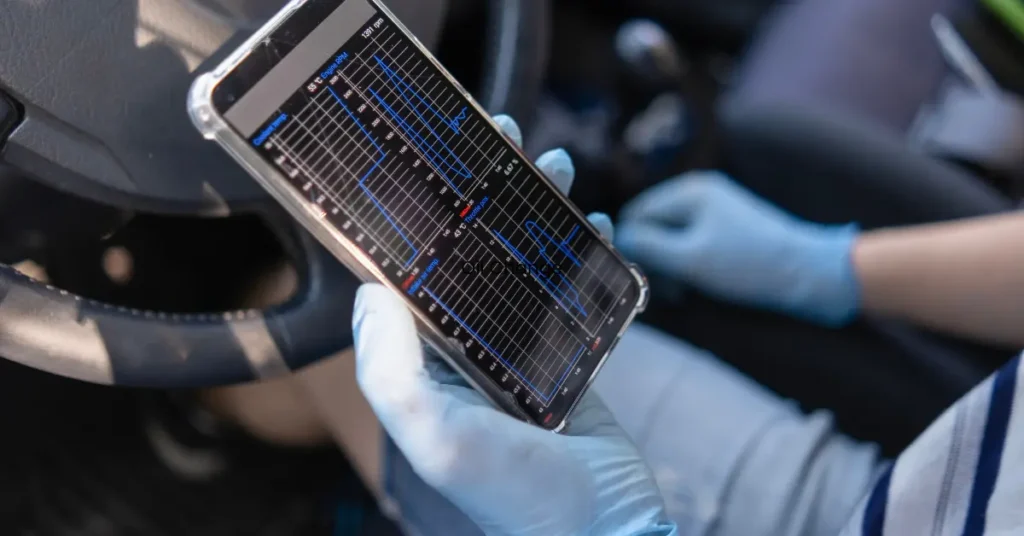
The P0305 GMC code in a vehicle indicates a misfire in the fifth cylinder of the engine. This can be a frustrating issue to deal with, as it can cause poor performance, rough idle, and even damage to the engine if left unresolved.
In this article, we will explore the possible causes of the P0305 code and how to clear specific code in a GMC vehicle and discuss the steps to diagnose and fix this issue.
Contents
Possible Causes of the P0305 GMC Code
When the check engine light illuminates and the P0305 code is stored, it is essential to identify the root cause of the misfire. Here are some potential reasons why the misfire may be occurring in the fifth cylinder:
Ignition System Issues
Problems with the ignition system, such as a faulty spark plug or ignition coil, can result in a misfire. It is crucial to inspect and test these components to ensure they are functioning correctly.
A faulty spark plug can cause a weak or no spark, leading to a misfire in the fifth cylinder. It is recommended to replace all spark plugs at once for optimal performance.
An ignition coil that is not functioning properly may not deliver enough voltage to the spark plug, resulting in a misfire. If signs of wear, damage, or corrosion are found, the ignition coil should be replaced.
Fuel Delivery Problems
Insufficient fuel supply to the fifth cylinder can cause a misfire. Clogged fuel injectors or a malfunctioning fuel pump may be to blame. It is important to check the fuel system for any issues that could be affecting the delivery of fuel to the cylinder.
Clogged fuel injectors can restrict fuel flow to the fifth cylinder, leading to a misfire. They can be cleaned using specialized cleaning solutions. In severe cases, replacement may be necessary.
A malfunctioning fuel pump may not be delivering enough fuel pressure to the fifth cylinder. It should be inspected and replaced if necessary to ensure proper fuel delivery.
Compression Loss
If there is a loss of compression in the fifth cylinder, it can lead to a misfire. This can be caused by a damaged piston, worn piston rings, or a faulty valve. A compression test should be performed to determine if this is the underlying problem.
A damaged piston or worn piston rings can result in low compression in the fifth cylinder. Repairing or replacing these components may be necessary to restore proper compression.
A faulty valve can also cause compression loss. If a valve is not sealing properly, it should be inspected and replaced if needed.
Vacuum Leaks

Leaks in the intake manifold or vacuum hoses can disrupt the air-fuel mixture, resulting in a misfire. Thoroughly inspecting these components for any signs of damage or leaks is necessary.
Leaks in the intake manifold can allow unmetered air to enter the engine, causing a lean air-fuel mixture and potentially leading to a misfire. Any leaks should be repaired or sealed.
Damaged or disconnected vacuum hoses can also cause vacuum leaks. They should be inspected and replaced if necessary.
Engine Control Module (ECM) Malfunction
A malfunctioning ECM, which is responsible for controlling various engine functions, can contribute to a misfire. It is important to check for any error codes related to the ECM and perform necessary diagnostics.
Error codes related to the ECM should be retrieved using an OBD-II scanner. If a malfunctioning ECM is identified, it may need to be replaced or reprogrammed to ensure proper control of engine functions.
Diagnosing the P0305 Code
To diagnose the P0305 code accurately, it is recommended to follow these steps:
Scan the Vehicle
Use an OBD-II scanner to retrieve the trouble codes stored in the vehicle’s computer system. The P0305 code will indicate a misfire in the fifth cylinder.
Inspect the Ignition System
Check the condition of the spark plug and ignition coil in the fifth cylinder. If any signs of wear, damage, or corrosion are found, they should be replaced.
Remove the spark plug and visually inspect it for signs of wear, such as worn electrodes or heavy carbon buildup. If any abnormalities are found, the spark plug should be replaced.
Inspect the ignition coil for any physical damage or signs of corrosion. If present, the ignition coil should be replaced.
Check Fuel Delivery
Examine the fuel injectors and fuel pump for any issues that could hinder fuel supply to the fifth cylinder. Clean or replace clogged injectors and ensure the fuel pump is functioning correctly.
Remove the fuel injectors and inspect them for any clogs or deposits. If clogged, they can be cleaned using specialized cleaning solutions. In severe cases, replacement may be necessary.
Test the fuel pump to ensure it is delivering adequate fuel pressure to the fifth cylinder. If the fuel pump is not functioning properly, it should be replaced.
Perform a Compression Test
Test the compression in the fifth cylinder to determine if there is any loss of compression. If the compression readings are low, further investigation into potential causes, such as damaged piston rings or valves, may be required.
Remove the spark plug from the fifth cylinder and connect a compression gauge to the spark plug hole.
Crank the engine several times and record the compression readings.
Compare the readings to the manufacturer’s specifications. If the readings are significantly lower than the specified range, further inspection of the piston rings or valves may be necessary.
Inspect for Vacuum Leaks
Carefully inspect the intake manifold and vacuum hoses for any leaks or damages. Address any issues found during the inspection to ensure proper air-fuel mixture.
Visually inspect the intake manifold for any signs of cracks or damage. Replace or repair the intake manifold if any issues are found.
Inspect all vacuum hoses for cracks, leaks, or disconnections. Replace any damaged hoses.
Check the ECM

If all other potential causes have been ruled out, it is essential to verify the functionality of the ECM. This can be done by performing diagnostic tests or consulting with a professional technician.
Retrieve any error codes related to the ECM using an OBD-II scanner. Follow the manufacturer’s diagnostic procedures to troubleshoot and repair any ECM-related issues.
Solving the P0305 Code
Once the cause of the P0305 code has been identified, appropriate measures can be taken to fix the issue. Here are some common solutions:
These solutions are not only helpful in clearing the code from GMC but can also be helpful to clear codes for other brand cars having the same misfire issues.
Replace Faulty Ignition Components
If the spark plug or ignition coil is found to be faulty, they should be replaced with new ones. It is recommended to replace all spark plugs at once for optimal performance.
Clean or Replace Clogged Fuel Injectors
If the fuel injectors are clogged, they can be cleaned using specialized cleaning solutions. In severe cases, replacement may be necessary.
Repair Compression Issues
If a loss of compression is detected, further investigation is needed to pinpoint the exact cause. Depending on the extent of the damage, repairing or replacing the damaged components may be required.
Address Vacuum Leaks
If any vacuum leaks are found, they should be repaired or replaced accordingly. This will help restore the proper air-fuel mixture and eliminate the misfire.
ECM Replacement or Reprogramming
If the ECM is determined to be malfunctioning, it may need to be replaced or reprogrammed. This will ensure proper control of engine functions and prevent future misfires.
Conclusion
The P0305 code in a GMC vehicle indicates a misfire in the fifth cylinder. By identifying the possible causes and following the diagnostic and repair steps outlined in this article, you can effectively resolve the issue.
However, it is important to note that the complexity of the problem may vary depending on the specific GMC model and year. If you are unsure or uncomfortable with performing the diagnosis and repair yourself, it is recommended to seek assistance from a qualified technician.
FAQ
Q: What does the P0305 code in a GMC vehicle indicate?
The P0305 code indicates a misfire in the fifth cylinder of the engine in a GMC vehicle.
Q: What are some possible causes of the P0305 code?
Possible causes include ignition system issues, fuel delivery problems, compression loss, vacuum leaks, and engine control module (ECM) malfunction.
Q: How can I diagnose the P0305 code?
To diagnose the P0305 code, you can scan the vehicle using an OBD-II scanner, inspect the ignition system, check fuel delivery, perform a compression test, inspect for vacuum leaks, and check the ECM.
Q: What are some common solutions to fix the P0305 code?
Common solutions include replacing faulty ignition components, cleaning or replacing clogged fuel injectors, repairing compression issues, addressing vacuum leaks, and replacing or reprogramming the ECM if necessary.



